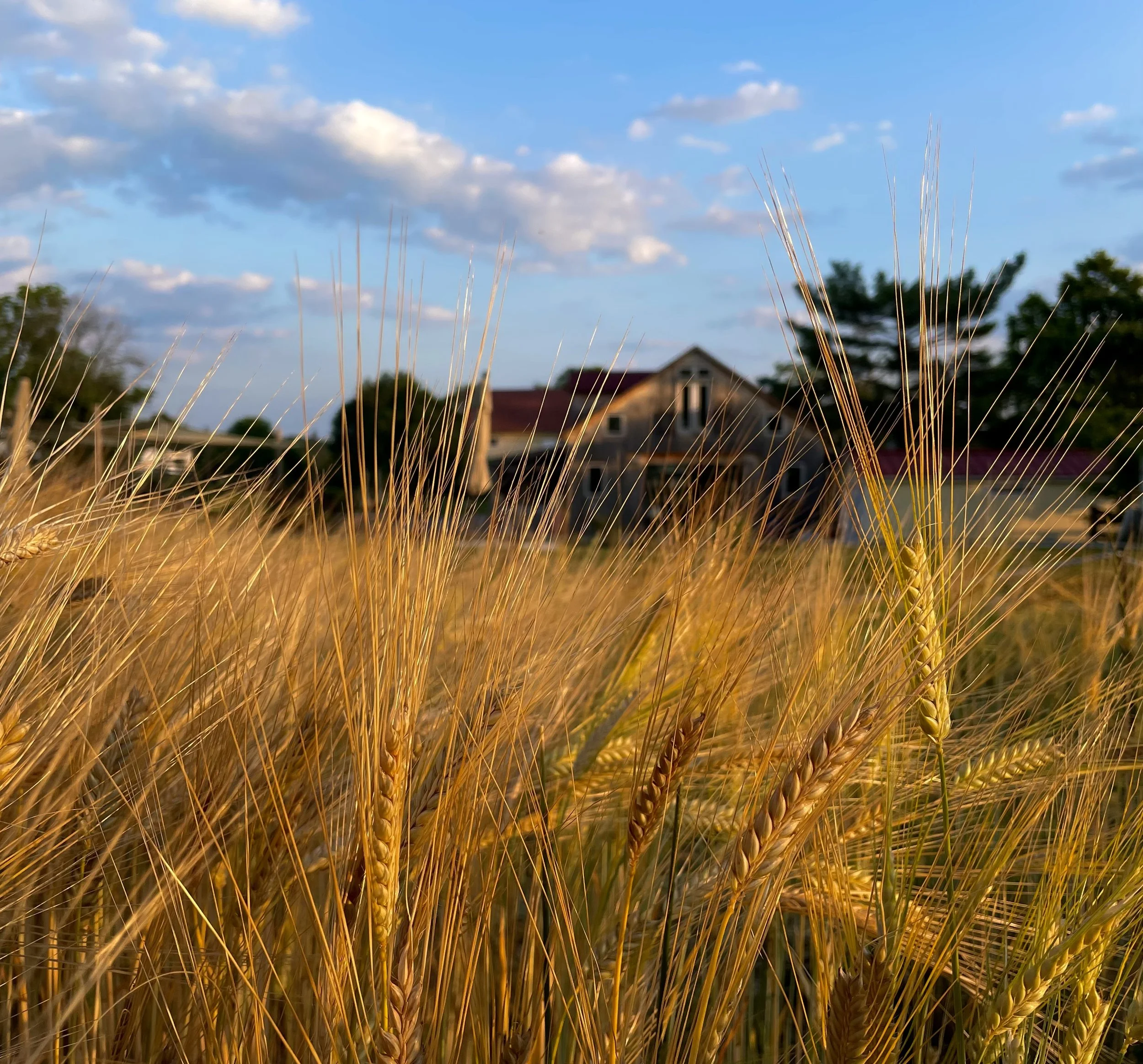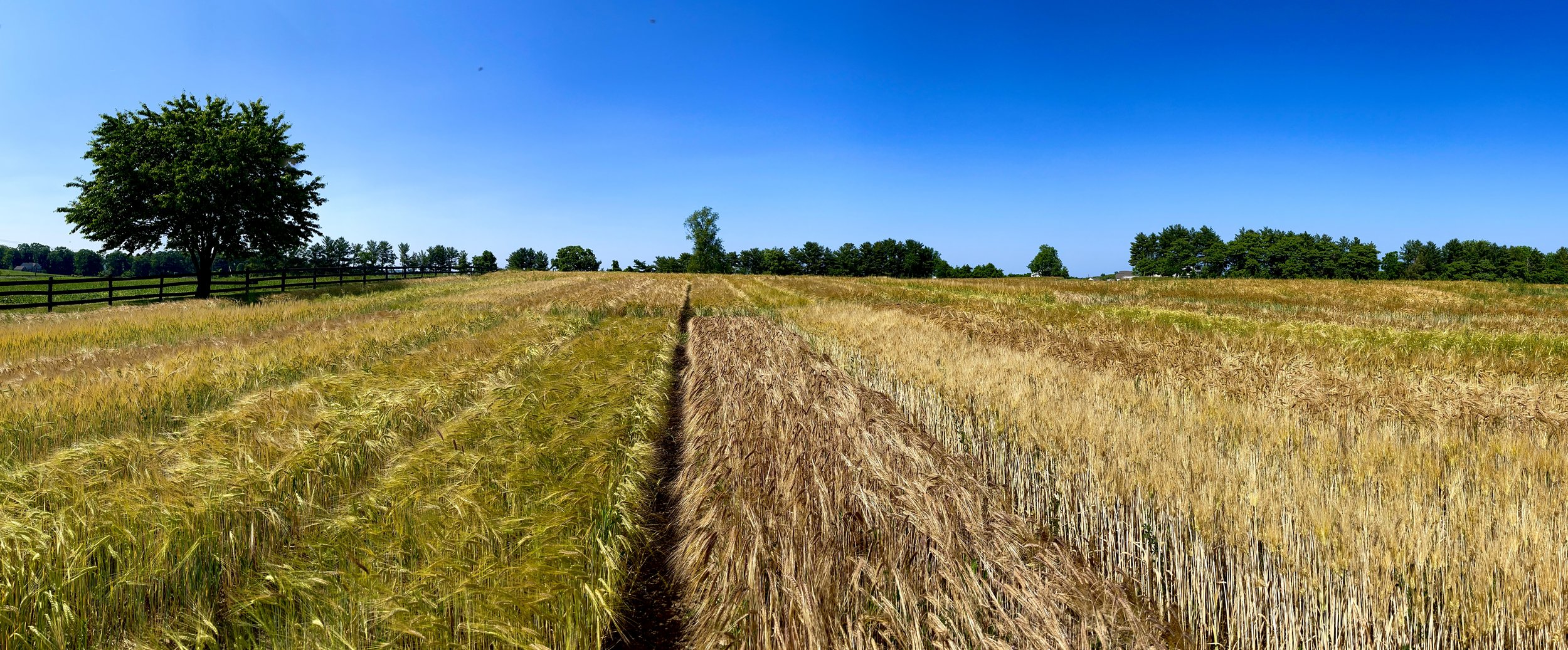Barley growing next to our Corn Crib brewhouse barn.
Estate production is a singular expression of produce, product, and people. It’s the heart of local.
The more we combine environmentalist and chef, winegrower and wine maker, orchardist and cider maker, grain farmer and brewer, the more opportunities we create to advance food and drink.
We make it big by creating it small. Have it be more by using less. And we expand its identity by bringing it close.
Estate production can serve as a bridge, connecting agriculture and community. It empowers all of us to participate in growing a new tradition through food and drink.
We’re glad to be on this journey with you.
GROWING A NEW TRADITION
Growing a New Tradition means a lot to us. It’s defined by both the new barley types we’re growing for your beer, as well as an approach to brewing that’s meant to celebrate small farms from our time and place.
Wheatland Spring is an estate brewery.
100% of our regenerative farming operations are dedicated to growing ingredients for our beer, focusing on acres of malting barley and other grains bred specifically for brewing. Since cereal grains are the largest single ingredient in beer beyond water, that’s where we focus our efforts on making beer from a place — today and tomorrow. More info on the what’s and why’s below.
Barley test plot next to our brewhouse. Behind it are acres of a malting barley for our beer, bred for our climate.
To see what’s ahead, sometimes it helps to first look down.
These are rows of experimental malting barley. It’s the second year we’re growing a test plot next to our brewhouse and Biergarten. One of these grains could be made into beer across our region some day.
Why do we think that? Behind these rows you’ll see acres of a malting barley we planted last year for our estate beers next year. This barley was also in a test row just like these. It’s now being planted by small farms across our region for beer.
Why does making beer with local grain matter?
Focus on flavor.
High quality beer that tastes like here.
The grain is happier.
Money stays small and local.
More small farms can grow profitable crops.
Reduces traffic and lowers emissions.
Barley view from the Granary Lounge in our Corn Crib.
View from the barley field to the brewhouse.
Big Innovation in Small Grain.
For us, re-connecting farming and brewing is the future of innovation in beer. We’re taking big steps forward to realize this future, starting with grain.
In October of 2021, we began sowing these seeds of innovation for tomorrow’s beer. For the first year of our barley project, it was a pleasure to host the Virginia Secretary of Agriculture and small grains researchers from Virginia Tech at Wheatland Spring. Virginia Tech, Murphy & Rude Malting, and Wheatland Spring have been working together for some time on this project.
what are we doing?
We’re planting experimental types of barley under real world conditions. We grow the grain Virginia Tech is studying, Murphy & Rude malts it, we brew with the malted barley, and then we all evaluate the beer — you can help with that part… for science! The data along the way will be shared with Virginia Tech to help inform their efforts on finding the next generation of local barley not only for the field (Virginia Tech focus) and malt house (Murphy & Rude focus), but also for the brewhouse and the glass (our focus). Turning local malting barley into delicious beer has to tick all of those boxes and this project speeds up the process.
Experimental barley cultivars growing at Wheatland Spring before harvest 2022.
How is this special?
By growing and brewing with the grain ourselves, we’re dramatically shrinking the time it takes to go from studying experimental grain to serving beer made from that grain. The typical path for brewing with a new barley type goes something like this: breed barley adapted to our climate —> ensure it performs well in the field —> identify barley that’s good for malting —> scale up the seed so it can be malted —> malt the barley —> brew beer with that barley —> finally taste the beer! This can take 10 years. We’re hoping to cut that timeline by more than half for the barley in our project.
Standing On the shoulders of giants.
While we’re planting it today, these seeds are the result of years of dedication and breakthrough work by cereal breeders. Like most everything in agriculture, this “overnight success” is the result of many years of intentional focus, long-term investment, and hard work by teams of people. Farmers, maltsters, brewers, and beer drinkers — today and tomorrow — owe them a debt of gratitude.
Harvesting the Wheatland Spring 2022 crop of experimental barley.
Why does local Grain matter?
HIGH QUALITY BEER THAT TASTES LIKE HERE. Local, craft malted grains are fresher and have full flavor expression, which makes delicious tasting beer.
THE GRAIN IS HAPPIER. Grain selected to grow well in our climate tends to be more robust and resistant to disease, so farmers need to rely less on inputs like pesticides.
MONEY STAYS SMALL AND LOCAL. Money you spend on beer made with local grain goes directly into the pockets of small farms and small businesses in our county, state, and region.
REDUCES TRAFFIC AND LOWERS EMISSIONS. There’s less congestion on our roads and fewer CO2 emissions because the grain is traveling much shorter distances.
Barley in our North Field.
Barley in our West Field.
Barley in our East Field getting ready.
Harvesting wheat in our West Field.
Small grain innovation can have a big impact and it’s a win all around. We’re just getting going and we hope you’ll join us.
Want to know more about why we only use craft malt?












